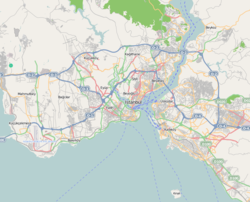Çinili Köşk
- Tür: Müze
- Tema: Restorasyondaki Yapılar
- Kültür: Osmanlı
- Yüzyıl: 15. yy
- Bölge: Türkiye, Marmara Bölgesi, İstanbul, Fatih, Cankurtaran
Fatih Sultan Mehmet’in Topkapı Sarayı’nda yaptırdığı ilk binadır. Sütunlarla hareketlendirilmiş cephesi ve çini kaplama eyvanıyla Selçuklu tesirinde bir erken Osmanlı mimarisidir. Çini Müzesi olarak kullanılmaktadır.
Çinili Köşk | |
 Front façade of the Tiled Kiosk | |
| Established | 1953 |
|---|---|
| Location | Alemdar Cad. Osman Hamdi Bey Yokuşu Sok. 34122, Gülhane Fatih, Istanbul |
| Coordinates | 41°00′43″N 28°58′53″E / 41.011944°N 28.981389°E |
| Type | Art museum |
| Website | www |
The Tiled Kiosk (Turkish: Çinili Köşk) is a pavilion set within the outer walls of Topkapı Palace and dates from 1472 as shown on the tile inscript above the main entrance.[1][2] It was built by the Ottoman sultan Mehmed II as a pleasure palace or kiosk. It is located in the most outer parts of the palace, next to Gülhane Park. It was also called Glazed Kiosk (Sırça Köşk).[3]
It was used as the Imperial Museum (Ottoman Turkish: Müze-i Hümayun, Turkish: İmparatorluk Müzesi) between 1875 and 1891.[4] In 1953, it was opened to the public as a museum of Turkish and Islamic art, and was later incorporated into the Istanbul Archaeology Museums, housing the Museum of Islamic Art. The pavilion contains many examples of İznik tiles and Seljuk pottery.
- ^ "History". Istanbul Archaeological Museums. Retrieved 2013-03-27.
- ^ Necipoğlu, Gülru (1991). Architecture, ceremonial, and power: The Topkapı Palace in the fifteenth and sixteenth centuries. Cambridge, Massachusetts: The MIT Press. pp. 213. ISBN 0-262-14050-0.
- ^ Davis, pg. 266
- ^ Davis, pg. 268














✶ İlgili Yerler
